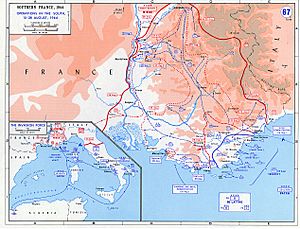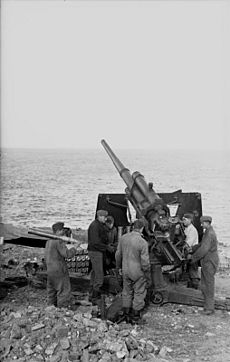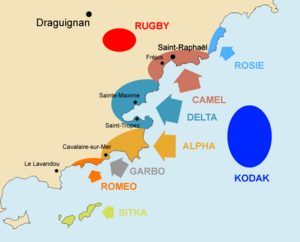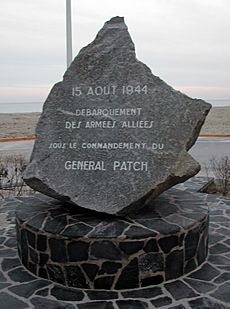Operation Dragoon facts for kids
Quick facts for kids Operation Dragoon |
|||||||||
|---|---|---|---|---|---|---|---|---|---|
| Part of the Mediterranean and Middle East Theatre and the European Theatre of World War II | |||||||||
 The Operation Dragoon invasion fleet off the coast of Southern France |
|||||||||
|
|||||||||
| Belligerents | |||||||||
|
Air support: Naval support: |
|||||||||
| Commanders and leaders | |||||||||
| Units involved | |||||||||
|
|
|
||||||||
| Strength | |||||||||
| Initial landing 151,000 personnel Entire invasion force 576,833 personnel French Resistance 75,000 personnel |
Initial landing 85,000–100,000 personnel 1,481 artillery pieces Southern France 285,000–300,000 personnel |
||||||||
| Casualties and losses | |||||||||
|
Total: ~25,574 |
~21,000 wounded 131,250 captured 1,316 artillery pieces Total: ~159,000 |
||||||||
Operation Dragoon was a major military operation during World War II. It was the code name for the Allied invasion of Southern France, specifically the region of Provence. This important landing took place on August 15, 1944.
The main goal of Operation Dragoon was to capture key ports on the French Mediterranean coast. This would help the Allies bring in more supplies and put extra pressure on the German forces. The invasion involved American and French troops, supported by a large naval force. They faced German forces that were not very strong, as many of their best units had been moved to other battlefronts.
The German forces were quickly defeated because the Allies controlled the skies. Also, the French Resistance (local fighters) helped a lot. The Germans had to retreat north through the Rhône valley. Allied mobile units tried to cut off their escape route at Montélimar, leading to a tough battle. While the Germans were retreating, French forces captured the important ports of Marseille and Toulon. These ports were quickly put to use, helping the Allies with their supply problems.
The fighting eventually stopped at the Vosges mountains. Here, the Germans managed to set up a strong defense line. Operation Dragoon was seen as a big success by the Americans. It helped liberate most of Southern France in just four weeks.
Contents
Background of the Operation
Planning the Invasion
The idea for invading Southern France came from General George Marshall in 1942. It was first called "Anvil" and was meant to happen at the same time as Operation Overlord, the D-Day landings in Normandy. However, there weren't enough ships and resources for both operations at once. So, Operation Anvil was put on hold.
Later, in July 1944, the Allies decided to go ahead with the invasion. The ports in Normandy were too busy to handle all the supplies needed for the Allied forces. Also, French leaders really wanted French troops to be part of a direct attack on Southern France. So, the operation was approved and renamed "Dragoon" on August 1. The landing was set for August 15.
Some leaders, like British Prime Minister Winston Churchill, disagreed with Operation Dragoon. He thought the resources should be used to help the Allied efforts in Italy instead. He wanted to attack the Balkans to cut off Germany's oil supply. But American President Franklin D. Roosevelt and General Dwight D. Eisenhower decided to stick with the plan for Southern France.
Goals and Strategy
The main goals of Operation Dragoon were to capture the important French ports of Marseille and Toulon. These ports were vital for bringing in supplies for the growing Allied forces in France. Planners learned from earlier landings, choosing a spot on the Var coast that didn't have high ground controlled by the Germans.
Before the main landing, Allied planes bombed German targets to cut off their supplies and communication lines. There was also a plan for paratroopers to land and capture high ground near the beaches. Special commando units were sent to take control of nearby islands.
The plan involved three divisions of US forces landing first to secure the beaches. French and American commando units would protect their sides. After the initial landing, French troops would come ashore to capture Toulon and Marseille. The American forces would then push north quickly to take Lyon and Dijon and meet up with Allied forces coming from Normandy.
The Germans knew an Allied landing was coming in the Mediterranean. However, their forces in Southern France were weak. Many of their best units had been sent to fight on other fronts. German commanders knew they couldn't stop a big Allied landing. They planned to retreat north to set up a new defense line at Dijon.
Who Fought in Operation Dragoon?
The Allied forces were a mix of different countries. The main ground force was the US Seventh Army, led by General Alexander Patch. It included the U.S. VI Corps and the French Army B. There was also a special mobile unit called "Task Force Butler" with tanks and armored vehicles.
The French Resistance (FFI) played a huge role. They were local fighters who sabotaged German bridges and communication lines. They also attacked isolated German forces, helping the Allies by tying down German troops. Allied special forces helped them with intelligence.
A huge air force of 3,470 planes supported the Allies. Most were based on Corsica and Sardinia. They bombed German airports, railroads, and defenses before the landing.
Facing the Allies was the German Army Group G, commanded by Johannes Blaskowitz. This group had only one army, the 19th Army, led by Friedrich Wiese. German forces in Southern France were not strong. Many of their best soldiers and equipment had been moved to other battle areas. The remaining 11 divisions were weak. Only one tank division, the 11th Panzer Division, was left.
Many German soldiers were older veterans or from Eastern Europe (called Ostlegionen). These units often had low morale and old equipment. Four German divisions were "static," meaning they couldn't move from their positions. The German air force and navy in the area were very small and played little part in the fighting. However, the Germans had built strong coastal defenses with heavy guns.
The Operation Begins
Early Attacks and Landings
Before the main invasion, special commando units carried out important missions. They attacked the Hyères Islands to silence German guns that could reach the landing beaches. The First Special Service Force, a joint U.S.-Canadian unit, took these islands after some fighting.
Another group of French commandos destroyed German artillery at Cap Nègre. There was also a deception plan called "Operation Span" to confuse the Germans with fake landings.
In the early hours of August 15, paratroopers and glider troops landed. The 1st Airborne Task Force landed near Le Muy. Their job was to stop German reinforcements from reaching the beaches. British paratroopers also landed, securing key villages and bridges. Despite some landing errors due to fog, the airborne landings were successful. They captured Le Muy and many German prisoners.
Main Invasion Force Lands
The Allied bombing and French Resistance sabotage had already weakened the Germans. The main landing began on the morning of August 15. Over 1,300 Allied bombers attacked German positions before the ships approached. Battleships and cruisers then fired on specific targets.
The main landing force included three US divisions. The U.S. 3rd Infantry Division landed at Alpha Beach, the 45th Infantry Division at Delta Beach, and the U.S. 36th Infantry Division at Camel Beach.
The landings were very successful. On Delta and Alpha beaches, German resistance was light. Many German soldiers surrendered quickly. The biggest danger was from mines. Allied units quickly secured their beachheads and linked up with the paratroopers.
The toughest fighting was at Camel Beach near Saint-Raphaël. This beach had strong German coastal guns. Even with heavy fire, the Allies struggled to land in one section. They decided to avoid that section and land successfully at other parts of Camel Beach.
Allied casualties were very low, with only 95 killed and 385 wounded. One tank landing ship was sunk by a German guided bomb, causing 40 of those casualties.
German Counterattacks and Retreat
French Resistance sabotage and Allied bombing caused a lot of confusion for the Germans. Their commanders couldn't easily communicate. Despite this, German commanders tried to counterattack. The German LXII Corps, trapped in Draguignan, ordered the 148th Infantry Division to attack the beaches.
However, the Allies had already landed many troops, vehicles, and tanks. The 45th Division quickly moved against the German forces. After heavy fighting, the Germans had to retreat. By August 17, German counterattacks had mostly failed. Saint-Raphaël was secured, and the Allies had a large beachhead. French troops began landing to move towards Toulon and Marseille.
The German high command realized they couldn't push the Allies back into the sea. They decided to withdraw all German forces from Southern France. They planned to move north to create a new defense line. The Allies knew about this plan because they had intercepted German communications.
The German Navy's response was very small. A few German ships were sunk by Allied destroyers. German U-boats in the area were mostly destroyed by air raids or scuttled (sunk by their own crews) to avoid capture.
Liberating French Cities
Taking Marseille and Toulon

While the Germans were retreating, French units began moving towards Marseille and Toulon. The French commander, Jean de Lattre de Tassigny, decided to attack both ports at almost the same time. He split his forces to encircle the cities.
The Germans had many troops in both cities but weren't ready for a strong defense. French forces reached Toulon on August 19. They surrounded the city and cut off the road to Marseille. Heavy fighting began on August 21. By August 26, the remaining German units in Toulon surrendered. The battle cost the French 2,700 casualties, but they captured 18,000 German soldiers.
At the same time, French troops attacked Marseille. Unlike Toulon, the German commander in Marseille did not evacuate civilians. The local population became very hostile, and fighting with French Resistance troops weakened the Germans. By August 27, most of Marseille was liberated. On August 28, German troops officially surrendered. This battle caused 1,825 French casualties, but 11,000 German troops were captured. In both ports, German engineers destroyed facilities to prevent the Allies from using them.
Many of the French Allied forces who helped liberate Toulon and Marseille were from the Free French Colonial Infantry Division. These included soldiers from Algeria, Mali, Mauritania, and Senegal.
The Battle at Montélimar
As Marseille and Toulon were being liberated, the German retreat continued. The Allies wanted to trap the Germans. Taskforce Butler, the Allied mechanized unit, was ordered to advance quickly and cut off the Germans further north. They found themselves near Montélimar, a small city directly on the German escape route.
On August 21, Taskforce Butler occupied hills north of Montélimar. From there, they fired on the retreating German troops. French Resistance fighters also helped by harassing the Germans. The Germans were surprised by this new threat. They sent their 11th Panzer Division to counterattack.
The battle at Montélimar was a stalemate for several days. The Allies didn't have enough supplies or men to completely block the German escape route. The Germans also struggled to move their troops into position. Both sides attacked and counterattacked.
Finally, between August 26 and 28, most of the German forces managed to escape. They left behind thousands of destroyed vehicles and dead horses. On August 29, the Allies captured Montélimar. The Germans lost 2,100 soldiers in battle and 8,000 were captured. The Americans had 1,575 casualties.
Final German Retreat
The Allied forces continued to chase the Germans north towards Dijon. The Germans tried to slow them down by destroying bridges. However, the Allies were still able to advance quickly.
On September 2, the 36th Infantry Division arrived at Lyon. They found French Resistance fighters battling local collaborators. Lyon was liberated the next day, and 2,000 Germans were captured. The rest had already retreated north.
The Allies tried one last time to cut off the Germans near Bourg-en-Bresse. But the Germans managed to hold their ground. On September 10, Allied units from Operation Dragoon met up with Patton's Third Army coming from Normandy.
On September 14, the Allied High Command ordered the offensive to stop. The German Army Group G finally managed to set up a stable defense line in the Vosges mountains. The Allies needed to reorganize their forces after linking up, so the pursuit ended.
During their retreat, the Germans also pulled out their remaining forces from southwestern France. About 88,000 men moved north, joining the defense in the Vosges Mountains.
What Happened After?
Operation Dragoon was a success for the Allies. They liberated most of Southern France in just four weeks. They also caused heavy losses for the German forces. However, they didn't manage to completely trap and destroy the best German units, which retreated in good order.
One big benefit of Operation Dragoon was getting access to the ports in Southern France, especially Marseille and Toulon. After the invasion, the Allied advance in France slowed down because of a lack of supplies. These ports were quickly repaired and put back into service. This allowed huge amounts of supplies to be brought in, helping the Allies continue their fight on the Western Front.
Operation Dragoon also had political effects. Two days after the landing, the Germans took control of the French government that had been cooperating with them. With this government collapsing, the Provisional Government of the French Republic took back control of France.
Some Allied generals and historians later criticized Operation Dragoon. They argued that the resources used in Southern France could have been better used elsewhere, like in Italy or to speed up the advance towards Germany from Normandy. However, it's clear that Operation Dragoon played a key role in liberating France and helping the Allies win World War II.
See also
- Battle of Port Cros
- Battle of La Ciotat
- Liberation of France







